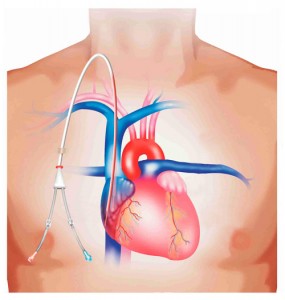Placement
- Internal jugular vein
- Femoral vein
- The subclavian vein
Advantages
- In the absence of other vascular pathways or until a vascular pathway is formed
- Can be used as soon as placed
- Can be set in different areas
Disadvantages
- Obstruction (seizure)
- Risk of infection
- Low velocity blood flow
- Dysfunction related to central vascular stenosis
Possible complications
Early
- The function of artery
- Bleeding
- Subcutaneous hematoma
- Hemothorax
- Arrhythmia
- Air embolism
- Perforation of the vein and pericardium
- Cardiac tamponade
Late
- Sepsis
- Endocarditis
- Thrombosis
- Abscess, phlegmon along the tunnel
- Stenosis of the vessel
Care of permanent catheters
Preparing the catheter for the session
- A nurse wears gloves and a mask
- Carefully open the bandage on the catheter (do not use scissors or other cutting tools, do not use alcohol and alcohol-containing solutions to wet the bandage).
- After the catheter ends are opened, they are wiped with 10% povidone-iodine solution and then with sterile gauze.
- Heparin is aspirated from the catheter port.
- The permeability of the catheter is checked with 0.9% NaCl solution
- HD procedure is started.
- At the end of HD, the lumen of the catheter is washed with 0.9% NaCl solution.
- The lumen is filled with pure heparin according to the appropriate volume.
Dressing the catheter:
- A mask is put on the patient.
- After the nurse puts on the mask and gloves, the bandage is removed.
- The area is treated with a sterile dressing material and with solution of chlorhexidine.
- An aseptic dressing is applied with a nonallergic plaster.
- The doctor must be informed If there is hyperemia at the exit site of the catheter.
Note: catheters are washed with streptokinase solution on the last Sunday of every month

